Optical and X-Ray Variability of Gamma Cas Analogs
Abstract
1. Introduction
2. The General Characteristic of Cas Analogs
3. Optical Spectra of Cas Analogs
4. Line Profile Variability
5. X-Ray Variability
6. Discussion
7. Conclusions
Funding
Institutional Review Board Statement
Informed Consent Statement
Data Availability Statement
Acknowledgments
Conflicts of Interest
References
- Porter, J.M.; Rivinius, T. Classical Be Stars. Publ. Astron. Soc. Pac. 2003, 115, 1153–1170. [Google Scholar] [CrossRef]
- Rivinius, T.; Klement, R. Classical Be stars. arXiv 2024, arXiv:2411.06882. [Google Scholar] [CrossRef] [PubMed]
- Rivinius, T.; Carciofi, A.C.; Martayan, C. Classical Be stars. Rapidly rotating B stars with viscous Keplerian decretion disks. Astron. Astrophys. Rev. 2013, 21, 69. [Google Scholar] [CrossRef]
- Silaj, J.; Jones, C.E.; Tycner, C.; Sigut, T.A.A.; Smith, A.D. A Systematic Study of Hα Profiles of Be Stars. Astrophys. J. Suppl. 2010, 187, 228–250. [Google Scholar] [CrossRef]
- Kholtygin, A.F.; Dodin, A.V.; Yakunin, I.A.; Ryspaeva, E.B. Optical and X-Ray Variability of Be Stars: Omega Ori. Astrophys. Bull. 2025, 81, 49–56. [Google Scholar] [CrossRef]
- Baade, D.; Labadie-Bartz, J.; Rivinius, T.; Carciofi, A.C. The historical active episodes of the disks around γ Cassiopeiae (B0.5 IVe) and 59 Cygni (B1 IVe) revisited. Astron. Astrophys. 2023, 678, A47. [Google Scholar] [CrossRef]
- Makarenko, E.I.; Igoshev, A.P.; Kholtygin, A.F. Testing the fossil field hypothesis: Could strongly magnetized OB stars produce all known magnetars? Mon. Not. R. Astron. Soc. 2021, 504, 5813–5828. [Google Scholar] [CrossRef]
- Hubrig, S.; Ilyin, I.; Kholtygin, A.F.; Schöller, M.; Skarka, M. Searching for the presence of a weak magnetic field in the Be star λ Eri using FORS 2 spectropolarimetric time series. Astron. Nachrichten 2017, 338, 926–937. [Google Scholar] [CrossRef]
- Valyavin, G.; Ikhsanov, N.R.; Beskrovnaya, N.G.; Gadelshin, D.; Galazutdinov, G.A.; Semenko, E.; Romanyuk, I.I.; Kholtygin, A.F.; Sabin, L.; Hiriart, D.; et al. Possible Detection of a Magnetic Field in X Persei. In Stars: From Collapse to Collapse; Balega, Y.Y., Kudryavtsev, D.O., Romanyuk, I.I., Yakunin, I.A., Eds.; Astronomical Society of the Pacific: San Francisco, CA, USA, 2017; Volume 510, p. 229. [Google Scholar]
- Grunhut, J.H.; Wade, G.A.; MiMeS Collaboration. The incidence of magnetic fields in massive stars: An overview of the MiMeS survey component. In Stellar Polarimetry: From Birth to Death; Hoffman, J.L., Bjorkman, J., Whitney, B., Eds.; American Institute of Physics: College Park, MD, USA, 2012; Volume 1429, pp. 67–74. [Google Scholar] [CrossRef]
- Wade, G.A.; Petit, V.; Grunhut, J.H.; Neiner, C.; MiMeS Collaboration. Magnetic Fields of Be Stars: Preliminary Results from a Hybrid Analysis of the MiMeS Sample. In Bright Emissaries: Be Stars as Messengers of Star-Disk Physics; Sigut, T.A.A., Jones, C.E., Eds.; Astronomical Society of the Pacific: San Francisco, CA, USA, 2016; Volume 506, p. 207. [Google Scholar]
- ud-Doula, A.; Owocki, S.P.; Kee, N.D. Disruption of circumstellar discs by large-scale stellar magnetic fields. Mon. Not. R. Astron. Soc. 2018, 478, 3049–3055. [Google Scholar] [CrossRef]
- Samus, N.N.; Kazarovets, E.V.; Durlevich, O.V.; Kireeva, N.N.; Pastukhova, E.N. General catalogue of variable stars: Version GCVS 5.1. Astron. Rep. 2017, 61, 80–88. [Google Scholar] [CrossRef]
- Nazé, Y.; Robrade, J. SRG/eROSITA survey of Be stars. Mon. Not. R. Astron. Soc. 2023, 525, 4186–4201. [Google Scholar] [CrossRef]
- Nazé, Y.; Motch, C. Hot stars observed by XMM-Newton. II. A survey of Oe and Be stars. Astron. Astrophys. 2018, 619, A148. [Google Scholar] [CrossRef]
- Smith, M.A.; Lopes de Oliveira, R.; Motch, C. A Census of the Class of X-ray Active γ Cas Stars. In Bright Emissaries: Be Stars as Messengers of Star-Disk Physics; Sigut, T.A.A., Jones, C.E., Eds.; Astronomical Society of the Pacific: San Francisco, CA, USA, 2016; Volume 506, p. 299. [Google Scholar]
- Nazé, Y.; Motch, C.; Rauw, G.; Kumar, S.; Robrade, J.; Lopes de Oliveira, R.; Smith, M.A.; Torrejón, J.M. Three discoveries of γ Cas analogues from dedicated XMM-Newton observations of Be stars. Mon. Not. R. Astron. Soc. 2020, 493, 2511–2517. [Google Scholar] [CrossRef]
- Nazé, Y.; Rauw, G.; Smith, M.A.; Motch, C. The X-ray emission of Be+stripped star binaries ★. Mon. Not. R. Astron. Soc. 2022, 516, 3366–3380. [Google Scholar] [CrossRef]
- Kholtygin, A.F.; Ryspaeva, E.B.; Yakunin, I.A.; Tsiopa, O.A. Variability of optical and X-ray spectra of Gamma Cassiopeia stars. INASAN Sci. Rep. 2023, 8, 86–92. [Google Scholar] [CrossRef]
- Krtička, J.; Kurfürst, P.; Krtičková, I. Magnetorotational instability in decretion disks of critically rotating stars and the outer structure of Be and Be/X-ray disks. Astron. Astrophys. 2015, 573, A20. [Google Scholar] [CrossRef][Green Version]
- Rauw, G.; Nazé, Y.; Motch, C.; Smith, M.A.; Guarro Fló, J.; Lopes de Oliveira, R. The X-ray Emission of γ Cassiopeiae During the 2020-2021 Disc Eruption. Astron. Astrophys. 2022, 664, A184. [Google Scholar] [CrossRef]
- Draper, Z.H.; Wisniewski, J.P.; Bjorkman, K.S.; Meade, M.R.; Haubois, X.; Mota, B.C.; Carciofi, A.C.; Bjorkman, J.E. Disk-loss and Disk-renewal Phases in Classical Be Stars. II. Contrasting with Stable and Variable Disks. Astrophys. J. 2014, 786, 120. [Google Scholar] [CrossRef]
- Wisniewski, J.P.; Draper, Z.H.; Bjorkman, K.S.; Meade, M.R.; Bjorkman, J.E.; Kowalski, A.F. Disk-Loss and Disk-Renewal Phases in Classical Be Stars. I. Analysis of Long-Term Spectropolarimetric Data. Astrophys. J. 2010, 709, 1306–1320. [Google Scholar] [CrossRef]
- Miroshnichenko, A.S.; Bjorkman, K.S.; Krugov, V.D. Binary Nature and Long-Term Variations of γ Cassiopeiae. Publ. Astron. Soc. Pac. 2002, 114, 1226–1233. [Google Scholar] [CrossRef]
- Bjorkman, K.S.; Miroshnichenko, A.S.; McDavid, D.; Pogrosheva, T.M. A Study of π Aquarii during a Quasi-normal Star Phase: Refined Fundamental Parameters and Evidence for Binarity. Astrophys. J. 2002, 573, 812–824. [Google Scholar] [CrossRef]
- Ruždjak, D.; Božić, H.; Harmanec, P.; Fiřt, R.; Chadima, P.; Bjorkman, K.; Gies, D.R.; Kaye, A.B.; Koubský, P.; McDavid, D.; et al. Properties and nature of Be stars. 26. Long-term and orbital changes of ζ Tauri. Astron. Astrophys. 2009, 506, 1319–1333. [Google Scholar] [CrossRef]
- Nazé, Y.; Rauw, G.; Czesla, S.; Smith, M.A.; Robrade, J. Velocity monitoring of γ Cas stars reveals their binarity status. Mon. Not. R. Astron. Soc. 2022, 510, 2286–2304. [Google Scholar] [CrossRef]
- Tsujimoto, M.; Hayashi, T.; Morihana, K.; Moritani, Y. X-ray and optical spectroscopic study of a γ Cassiopeiae analog source π Aquarii. Publ. Astron. Soc. Jpn. 2023, 75, 177–186. [Google Scholar] [CrossRef]
- Klement, R.; Rivinius, T.; Gies, D.R.; Baade, D.; Mérand, A.; Monnier, J.D.; Schaefer, G.H.; Lanthermann, C.; Anugu, N.; Kraus, S.; et al. The CHARA Array Interferometric Program on the Multiplicity of Classical Be Stars: New Detections and Orbits of Stripped Subdwarf Companions. Astrophys. J. 2024, 962, 70. [Google Scholar] [CrossRef]
- Gies, D.R.; Wang, L.; Klement, R. Gamma Cas Stars as Be+White Dwarf Binary Systems. Astrophys. J. Lett. 2023, 942, L6. [Google Scholar] [CrossRef]
- Wang, L.; Gies, D.R.; Peters, G.J.; Han, Z. The Orbital and Physical Properties of Five Southern Be+sdO Binary Systems. Astron. J. 2023, 165, 203. [Google Scholar] [CrossRef]
- Secchi, A. Schreiben des Herrn Prof. Secchi, Directors der Sternwarte des Collegio Romano, an den Herausgeber. Astron. Nachrichten 1866, 68, 63. [Google Scholar] [CrossRef]
- Campbell, W.W. Stars whose spectra contain both bright and dark hydrogen lines. Astrophys. J. 1895, 2, 177–183. [Google Scholar] [CrossRef]
- Merrill, P.W.; Humason, M.L.; Burwell, C.G. Discovery and Observations of Stars of Class Be. Astrophys. J. 1925, 61, 389–417. [Google Scholar] [CrossRef]
- Merrill, P.W.; Burwell, C.G. Catalogue and Bibliography of Stars of Classes B and A whose Spectra have Bright Hydrogen Lines. Astrophys. J. 1933, 78, 87. [Google Scholar] [CrossRef]
- Struve, O. On the Origin of Bright Lines in Spectra of Stars of Class B. Astrophys. J. 1931, 73, 94. [Google Scholar] [CrossRef]
- Neiner, C.; de Batz, B.; Cochard, F.; Floquet, M.; Mekkas, A.; Desnoux, V. The Be Star Spectra (BeSS) Database. Astron. J. 2011, 142, 149. [Google Scholar] [CrossRef]
- Neiner, C. The BeSS database: A fruitful professional-amateur collaboration. In Proceedings of the SF2A-2018: Proceedings of the Annual Meeting of the French Society of Astronomy and Astrophysics, Bordeaux, France, 3–6 July 2018; Di Matteo, P., Billebaud, F., Herpin, F., Lagarde, N., Marquette, J.B., Robin, A., Venot, O., Eds.; pp. 237–240. [Google Scholar] [CrossRef]
- Kholtygin, A.; Yakunin, I.; Ryspaeva, E.; Mokshin, D. A nature of the X-ray and optical emission from gamma Cassiopeia stars. In Proceedings of the Modern Astronomy: From the Early Universe to Exoplanets and Black Holes, VAK2024, Moscow, Russia, 25–31 August 2024; pp. 402–408. [Google Scholar] [CrossRef]
- Ikonnikova, N.P.; Shaposhnikov, I.A.; Esipov, V.F.; Burlak, M.A.; Arkhipova, V.P.; Dodin, A.V.; Potanin, S.A.; Shatsky, N.I. Spectroscopic Variability of the Compact Planetary Nebula Hb 12. Astron. Lett. 2021, 47, 560–580. [Google Scholar] [CrossRef]
- Pollmann, E.; Vollmann, W.; Henry, G.W. Long-term monitoring of Halpha emission strength and photometric V magnitude of gamma Cas. Inf. Bull. Var. Stars 2014, 6109, 1. [Google Scholar]
- Kholtygin, A.K.; Burlak, M.A.; Tsiopa, O.A. Unusual Fast Spectral Variability of γ Cas. Astron. Tsirkulyar 2021, 1649, 1. [Google Scholar] [CrossRef]
- Kholtygin, A.F.; Yakunin, I.A.; Bukharinov, V.S.; Mokshin, D.N.; Ryspaeva, E.B.; Tsiopa, O.A. Optical and X-Ray Variability of gamma Cas Stars II: SAO 49725. Astrophys. Bull. 2024, 79, 437–444. [Google Scholar] [CrossRef]
- Kholtygin, A.F.; Yakunin, I.A.; Burlak, M.A.; Ryspaeva, E.B. Optical and X-ray Variability of gamma Cas Stars: HD 45995. Astrophys. Bull. 2023, 78, 557–566. [Google Scholar] [CrossRef]
- Kholtygin, A.F.; Dodin, A.V.; Yakunin, I.A.; Ryspaeva, E.B. Optical and X-Ray Variability of gamma Cas Stars: V558 Lyr. Astrophys. Bull. 2025; in preparation. [Google Scholar]
- Kholtygin, A.F.; Moiseeva, A.V.; Kurdoyakova, M.S.; Yakunin, I.A.; Kostenkov, A.E.; Karataeva, G.M. Super-Fast Line-Profile Variability in the Spectra of OBA Stars. IV: ζ Ori A. Astrophys. Bull. 2021, 76, 185–195. [Google Scholar] [CrossRef]
- Kogure, T.; Hirata, R. The Be star phenomena. I. General properties. Bull. Astron. Soc. India 1982, 10, 281–309. [Google Scholar]
- Borre, C.C.; Baade, D.; Pigulski, A.; Panoglou, D.; Weiss, A.; Rivinius, T.; Handler, G.; Moffat, A.F.J.; Popowicz, A.; Wade, G.A.; et al. Short-term variability and mass loss in Be stars. V. Space photometry and ground-based spectroscopy of γ Cas. Astron. Astrophys. 2020, 635, A140. [Google Scholar] [CrossRef]
- Okazaki, A.T. Long-Term V/R Variations of Be Stars Due to Global One-Armed Oscillations of Equatorial Disks. Publ. Astron. Soc. Jpn. 1991, 43, 75–94. [Google Scholar] [CrossRef]
- Panchuk, V.E.; Chuntonov, G.A.; Naidenov, I.D. Main stellar spectrograph of the 6-meter telescope. Analysis, reconstruction, and operation. Astrophys. Bull. 2014, 69, 339–355. [Google Scholar] [CrossRef]
- Afanasiev, V.L.; Moiseev, A.V. The SCORPIO Universal Focal Reducer of the 6-m Telescope. Astron. Lett. 2005, 31, 194–204. [Google Scholar] [CrossRef]
- Nazé, Y.; Pigulski, A.; Rauw, G.; Smith, M.A. Let there be more variability in two γ Cas stars. Mon. Not. R. Astron. Soc. 2020, 494, 958–974. [Google Scholar] [CrossRef]
- Smith, M.A.; Henry, G.W.; Vishniac, E. Rotational and Cyclical Variability in γ Cassiopeia. Astrophys. J. 2006, 647, 1375–1386. [Google Scholar] [CrossRef]
- Henry, G.W.; Smith, M.A. Rotational and Cyclical Variability in γ Cassiopeiae. II. Fifteen Seasons. Astrophys. J. 2012, 760, 10. [Google Scholar] [CrossRef]
- Nazé, Y.; Rauw, G.; Pigulski, A. TESS light curves of γ Cas stars. Mon. Not. R. Astron. Soc. 2020, 498, 3171–3183. [Google Scholar] [CrossRef]
- Labadie-Bartz, J.; Baade, D.; Carciofi, A.C.; Rubio, A.; Rivinius, T.; Borre, C.C.; Martayan, C.; Siverd, R.J. Short-term variability and mass loss in Be stars—VI. Frequency groups in γ Cas detected by TESS. Mon. Not. R. Astron. Soc. 2021, 502, 242–259. [Google Scholar] [CrossRef]
- Ramsay, G.; Hakala, P.; Charles, P.A. A TESS search for donor-star pulsations in high-mass X-ray binaries. Mon. Not. R. Astron. Soc. 2022, 516, 1219–1236. [Google Scholar] [CrossRef]
- Gunderson, S.J.; Huenemoerder, D.P.; Torrejón, J.M.; Swarm, D.K.; Nichols, J.S.; Pradhan, P.; Ignace, R.; Guenther, H.M.; Pollock, A.M.T.; Schulz, N.S. A Time-dependent Spectral Analysis of γ Cassiopeiae. Astrophys. J. 2025, 978, 105. [Google Scholar] [CrossRef]
- Ryspaeva, E.B.; Kholtygin, A.F. A possible nonthermal X-ray emission from γ Cas analogues stars. Open Astron. 2021, 30, 132–143. [Google Scholar] [CrossRef]
- Bruch, A. Flickering in cataclysmic variables: Its properties and origins. Astron. Astrophys. 1992, 266, 237–265. [Google Scholar]
- Smith, M.A.; Lopes de Oliveira, R.; Motch, C. Characterization of the X-Ray Light Curve of the γ Cas-like B1e Star HD 110432. Astrophys. J. 2012, 755, 64. [Google Scholar] [CrossRef]
- Smith, M.A.; Lopes de Oliveira, R. Soft and hard X-ray dips in the light curves of γ Cassiopeiae. Mon. Not. R. Astron. Soc. 2019, 488, 5048–5056. [Google Scholar] [CrossRef]
- Parmar, A.N.; Israel, G.L.; Stella, L.; White, N.E. The X-ray time variability and spectrum of gamma Cassiopeiae (X 0053+604). Astron. Astrophys. 1993, 275, 227–235. [Google Scholar]
- Horaguchi, T.; Kogure, T.; Hirata, R.; Kawai, N.; Matsuoka, M.; Murakami, T.; Doazan, V.; Slettebak, A.; Huang, C.C.; Cao, H.; et al. The Be Star Gamma Cassiopeiae: X-Ray, Far-UV, and Optical Observations in Early 1989. Publ. Astron. Soc. Jpn. 1994, 46, 9–26. [Google Scholar] [CrossRef]
- Frontera, F.; dal Fiume, D.; Robba, N.R.; Manzo, G.; Re, S.; Costa, E. Time Variability of Gamma Cassiopeiae in X-Rays. Astrophys. J. 1987, 320, L127. [Google Scholar] [CrossRef]
- Haberl, F. γ Cassiopeiae: Evidence for a Be star/white dwarf X-ray binary? Astron. Astrophys. 1995, 296, 685. [Google Scholar]
- Owens, A.; Oosterbroek, T.; Parmar, A.N.; Schulz, R.; Stüwe, J.A.; Haberl, F. BeppoSAX broad-band observations of Gamma Cassiopeiae. Astron. Astrophys. 1999, 348, 170–174. [Google Scholar] [CrossRef]
- Smith, M.A.; Robinson, R.D.; Corbet, R.H.D. A Multiwavelength Campaign on γ Cassiopeiae. I. The Case for Surface X-Ray Flaring. Astrophys. J. 1998, 503, 877–893. [Google Scholar] [CrossRef]
- Robinson, R.D.; Smith, M.A. A Search for Rotational Modulation of X-Ray Centers on the Classical BE Star γ Cassiopeiae. Astrophys. J. 2000, 540, 474–488. [Google Scholar] [CrossRef]
- Murakami, T.; Koyama, K.; Inoue, H.; Agrawal, P.C. X-Ray Spectrum from Gamma Cassiopeiae. Astrophys. J. 1986, 310, L31. [Google Scholar] [CrossRef]
- Kubo, S.; Murakami, T.; Ishida, M.; Corbet, R.H.D. ASCA X-Ray Observations of Gamma Cassiopeiae. Publ. Astron. Soc. Jpn. 1998, 50, 417–426. [Google Scholar] [CrossRef]
- Smith, M.A.; Robinson, R.D.; Hatzes, A.P. A Multiwavelength Campaign on γ Cassiopeiae. II. The Case for Corotating, Circumstellar Clouds. Astrophys. J. 1998, 507, 945–954. [Google Scholar] [CrossRef]
- Smith, M.A.; Robinson, R.D. A Multiwavelength Campaign on γ Cassiopeiae. III. The Case for Magnetically Controlled Circumstellar Kinematics. Astrophys. J. 1999, 517, 866–882. [Google Scholar] [CrossRef]
- Smith, M.A. Ultraviolet Activity as Indicators of Small-scale Magnetic Fields in γ Cassiopeiae. Publ. Astron. Soc. Pac. 2019, 131, 044201. [Google Scholar] [CrossRef]
- Rauw, G. X-Ray Emission of Massive Stars and Their Winds. In Handbook of X-Ray and Gamma-Ray Astrophysics; Bambi, C., Sangangelo, A., Eds.; Springer: Berlin/Heidelberg, Germany, 2022; p. 108. [Google Scholar] [CrossRef]
- Rauw, G.; Nazé, Y.; Smith, M.A.; Miroshnichenko, A.S.; Guarro Fló, J.; Campos, F.; Prendergast, P.; Danford, S.; González-Pérez, J.N.; Hempelmann, A.; et al. Intriguing X-ray and optical variations of the γ Cassiopeiae analog HD 45314. Astron. Astrophys. 2018, 615, A44. [Google Scholar] [CrossRef]
- Nazé, Y.; Rauw, G.; Smith, M. Surprises in the simultaneous X-ray and optical monitoring of π Aquarii. Astron. Astrophys. 2019, 632, A23. [Google Scholar] [CrossRef]
- Nazé, Y. Going Forward to Unveil the Nature of γ Cas Analogs. Galaxies 2025, 13, 8. [Google Scholar] [CrossRef]
- Smith, M.A.; Lopes de Oliveira, R.; Motch, C. The X-ray emission of the γ Cassiopeiae stars. Adv. Space Res. 2016, 58, 782–808. [Google Scholar] [CrossRef]
- Pols, O.R.; Cote, J.; Waters, L.B.F.M.; Heise, J. The formation of Be stars through close binary evolution. Astron. Astrophys. 1991, 241, 419. [Google Scholar]
- Shao, Y.; Li, X.D. On the Formation of Be Stars through Binary Interaction. Astrophys. J. 2014, 796, 37. [Google Scholar] [CrossRef]
- Habets, G.M.H.J. The evolution of a single and a binary helium star of 2.5 solar mass up to neon ignition. Astron. Astrophys. 1986, 165, 95–109. [Google Scholar]
- Raguzova, N.V. Population synthesis of Be/white dwarf binaries in the Galaxy. Astron. Astrophys. 2001, 367, 848–858. [Google Scholar] [CrossRef]
- Willems, B.; Kolb, U. Detached white dwarf main-sequence star binaries. Astron. Astrophys. 2004, 419, 1057–1076. [Google Scholar] [CrossRef]
- Postnov, K.; Oskinova, L.; Torrejón, J.M. A propelling neutron star in the enigmatic Be-star γ Cassiopeia. Mon. Not. R. Astron. Soc. 2017, 465, L119–L123. [Google Scholar] [CrossRef]
- Smith, M.A.; Lopes de Oliveira, R.; Motch, C. Is there a propeller neutron star in γ Cas? Mon. Not. R. Astron. Soc. 2017, 469, 1502–1509. [Google Scholar] [CrossRef]
- Rauw, G. Fluorescent Fe K line emission of γ Cas stars. I. Do γ Cas stars host propelling neutron stars? Astron. Astrophys. 2024, 682, A179. [Google Scholar] [CrossRef]
- Langer, N.; Baade, D.; Bodensteiner, J.; Greiner, J.; Rivinius, T.; Martayan, C.; Borre, C.C. γ Cas stars: Normal Be stars with discs impacted by the wind of a helium-star companion? Astron. Astrophys. 2020, 633, A40. [Google Scholar] [CrossRef]
- Shrader, C.R.; Hamaguchi, K.; Sturner, S.J.; Oskinova, L.M.; Almeyda, T.; Petre, R. High-energy Properties of the Enigmatic Be Star γ Cassiopeiae. Astrophys. J. 2015, 799, 84. [Google Scholar] [CrossRef]
- Rivinius, T.; Baade, D.; Štefl, S. Non-radially pulsating Be stars. Astron. Astrophys. 2003, 411, 229–247. [Google Scholar] [CrossRef]
- Lopes de Oliveira, R.; Smith, M.A.; Motch, C. γ Cassiopeiae: An X-ray Be star with personality. Astron. Astrophys. 2010, 512, A22. [Google Scholar] [CrossRef]
- Kholtygin, A.F.; Moiseeva, A.V.; Yakunin, I.A.; Burlak, M.A.; Ryspaeva, E.B.; Tsiopa, O.A.; Kurdoyakova, M.S. Superfast Stellar Pulsations from O to A Stars. Geomagn. Aeron. 2022, 62, 1136–1140. [Google Scholar] [CrossRef]
- Kholtygin, A.F.; Ryspaeva, E.B. gamma Cas Stars: The Origin of the X-ray Emission. Geomagn. Aeron. 2024, 64, 1267–1272. [Google Scholar] [CrossRef]
- Webb, N.A. Accreting white dwarfs. arXiv 2023, arXiv:2303.10055. [Google Scholar] [CrossRef]
- Kholtygin, A.F.; Dodin, A.V.; Tsiopa, O.A. Neutron Star Rotation Period in Spectra of X Per. Astron. Tsirkulyar 2025, 1660, 1–5. [Google Scholar]

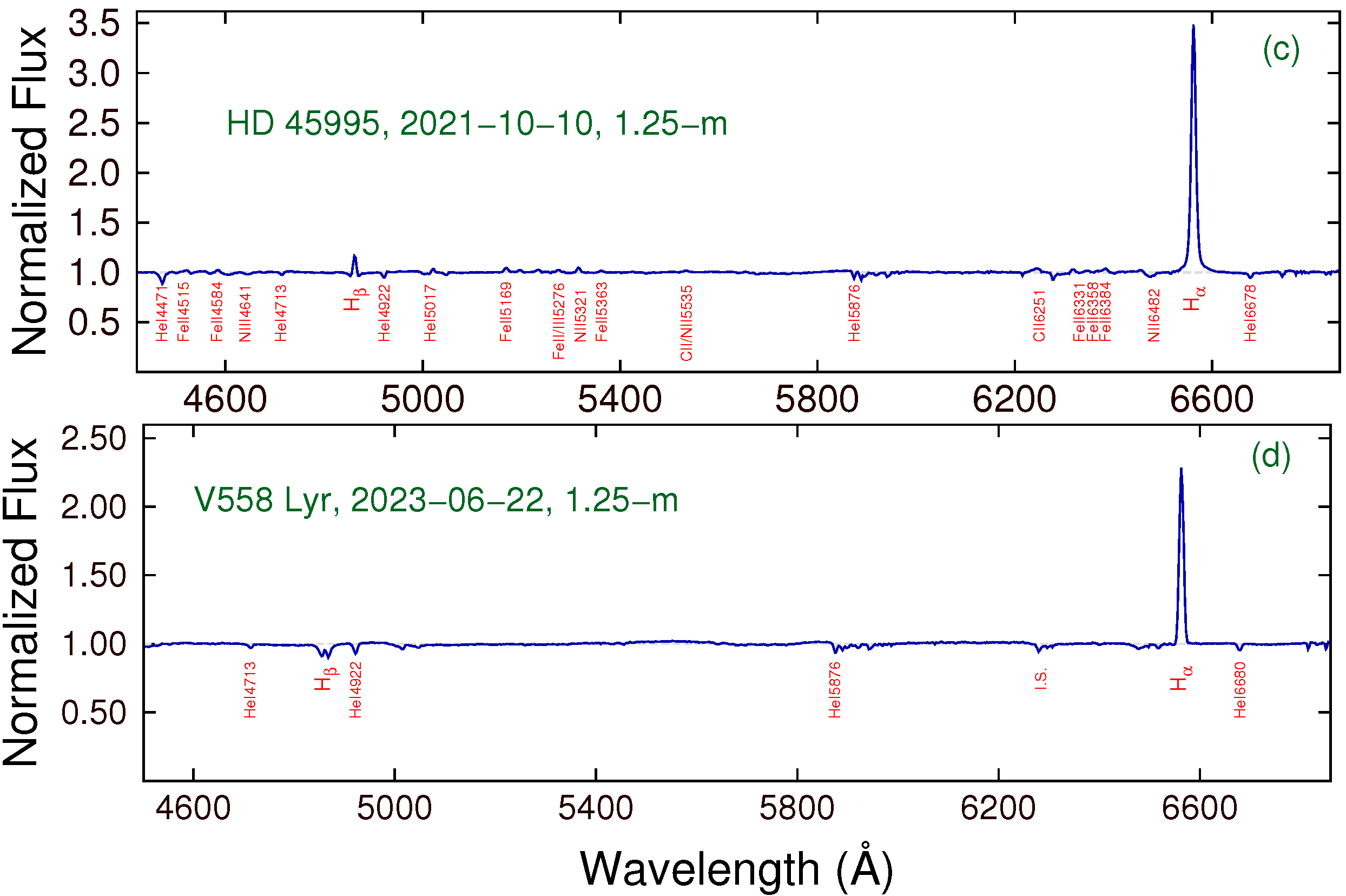
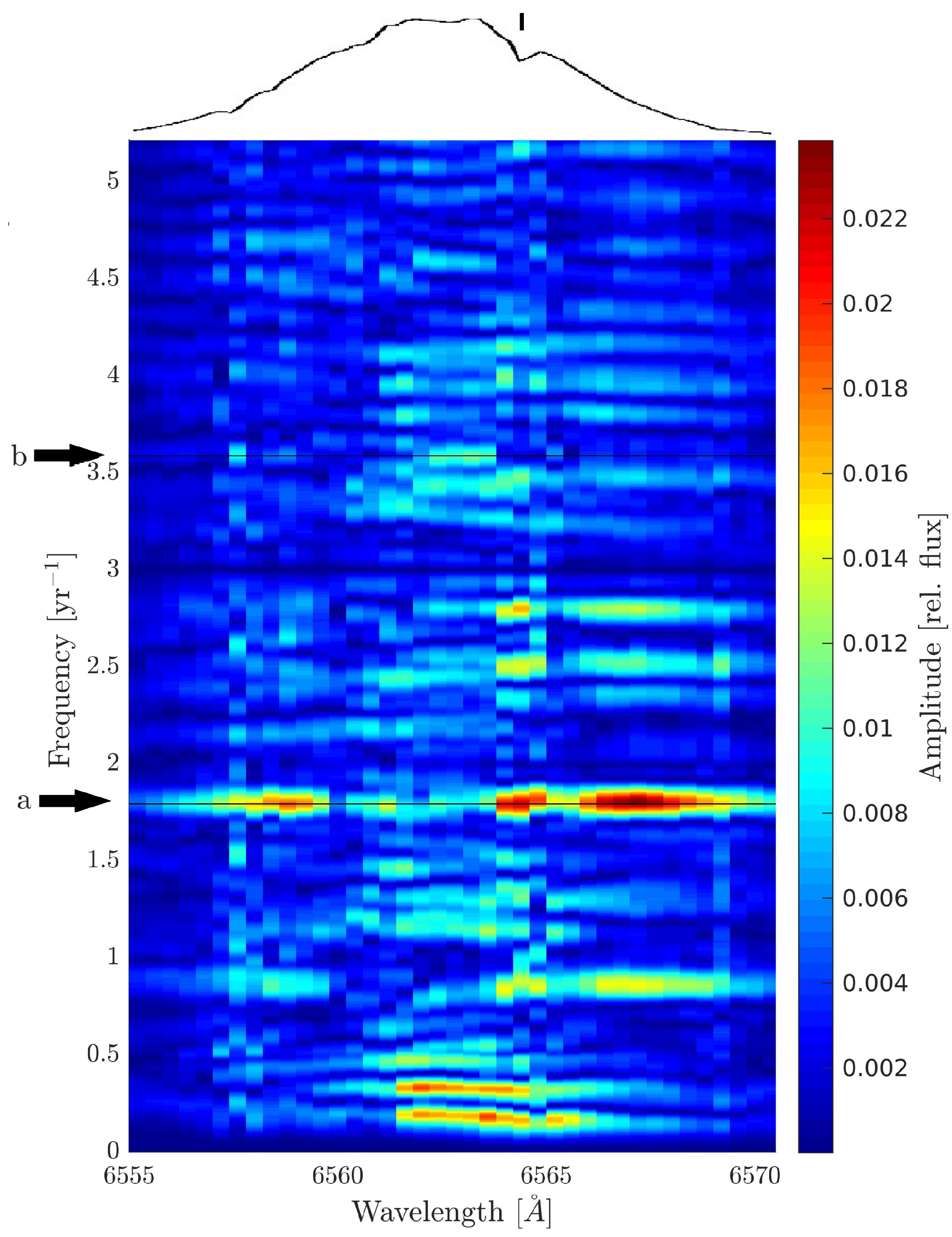
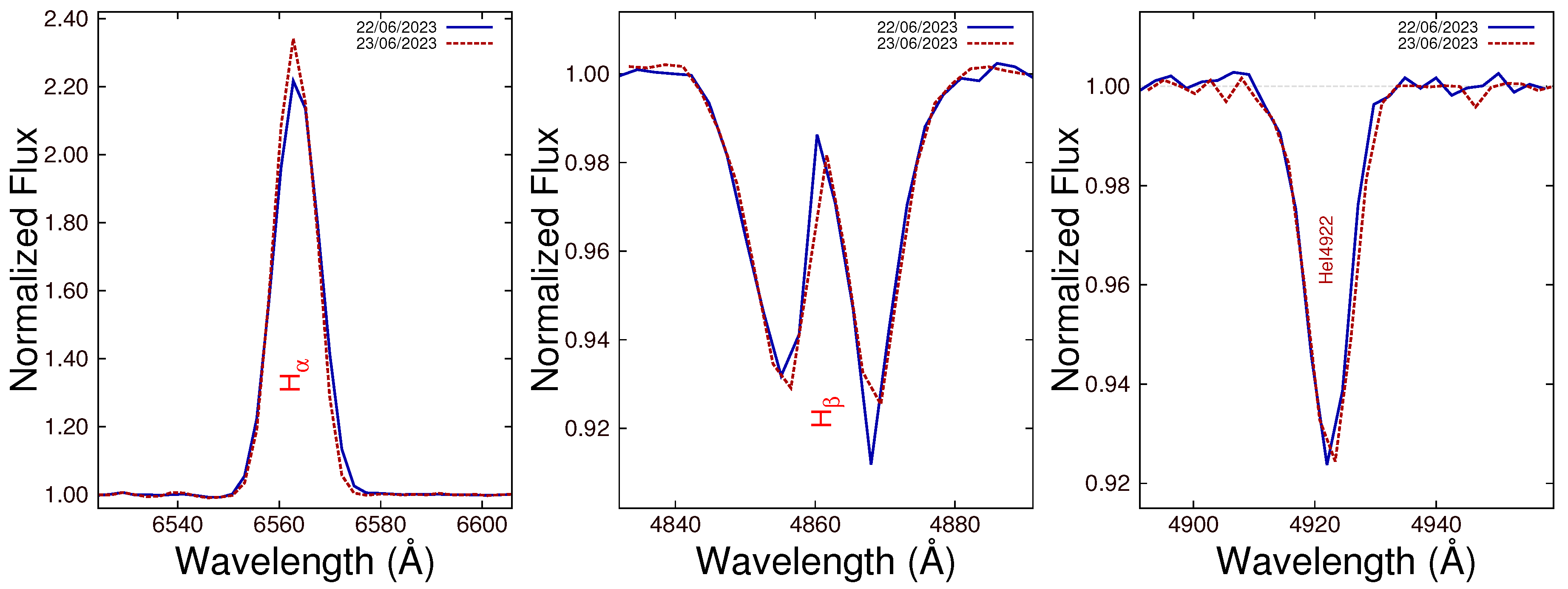
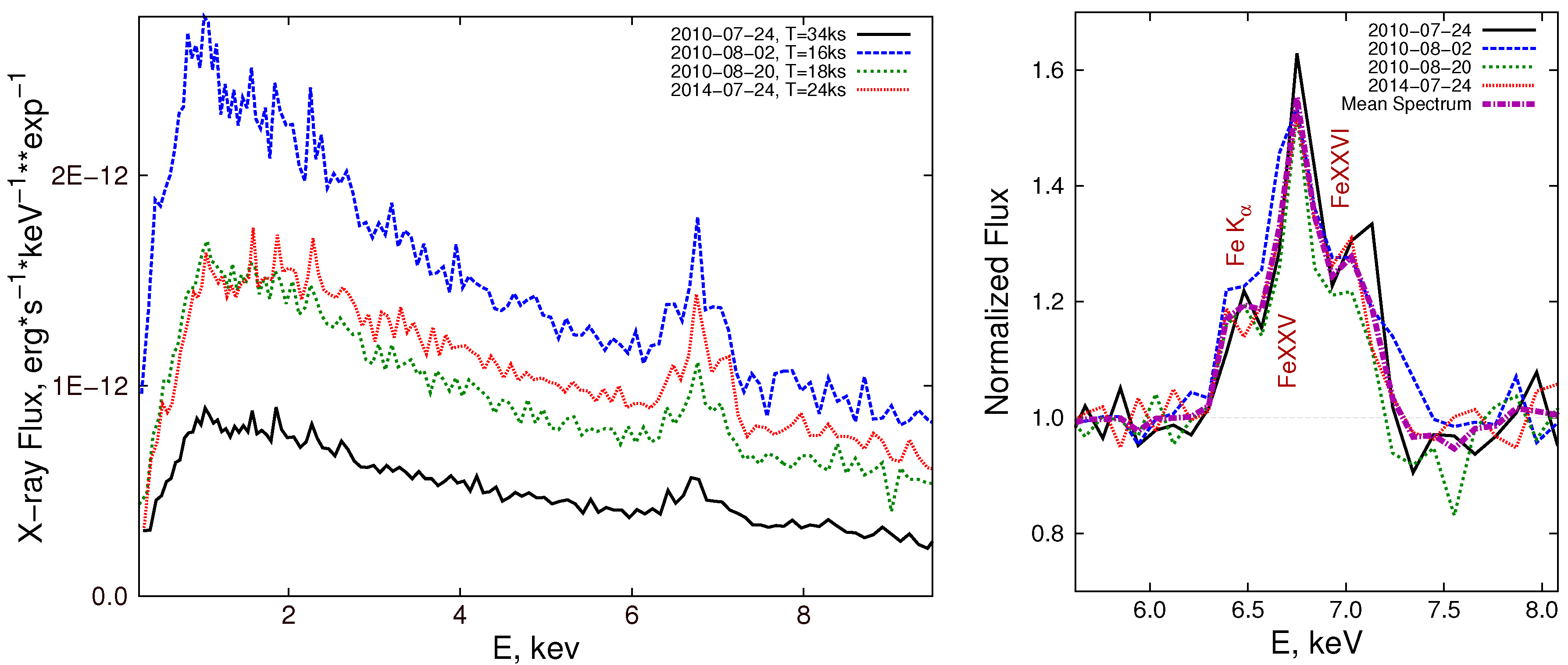
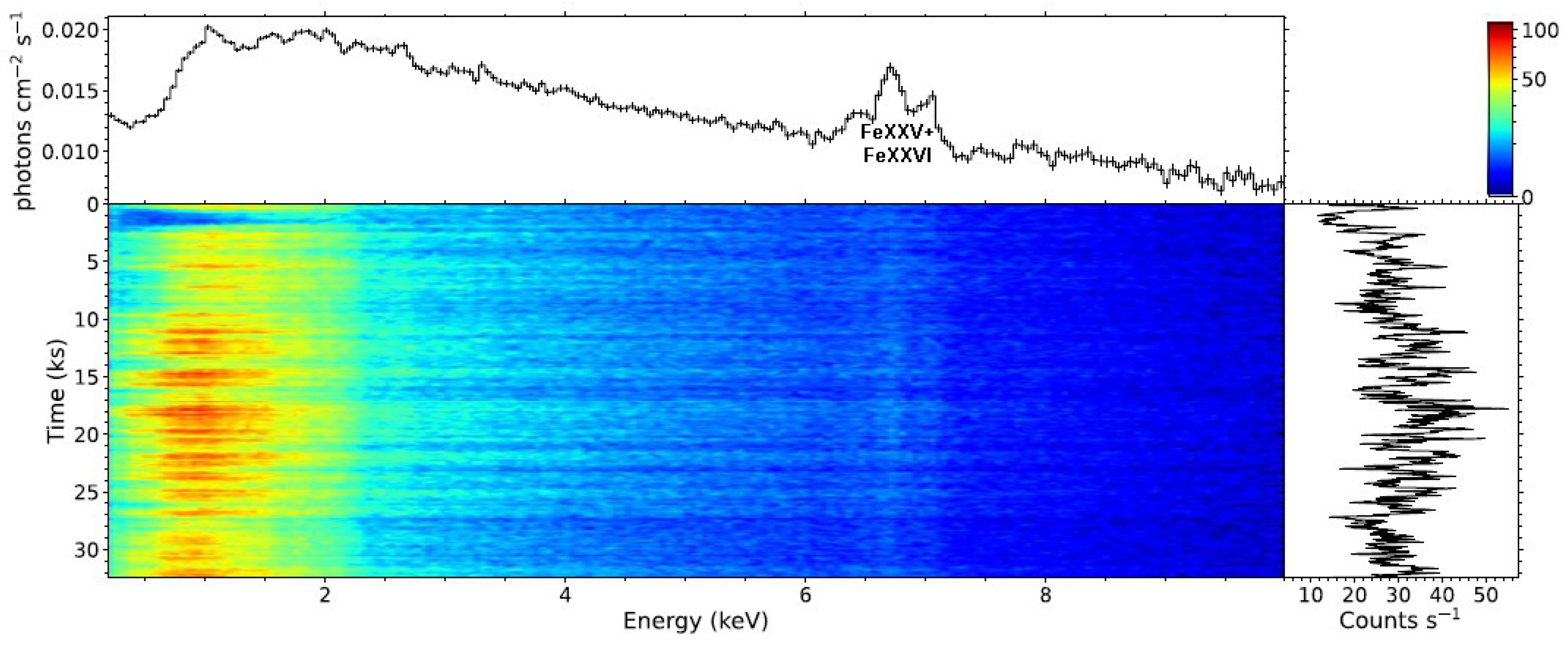
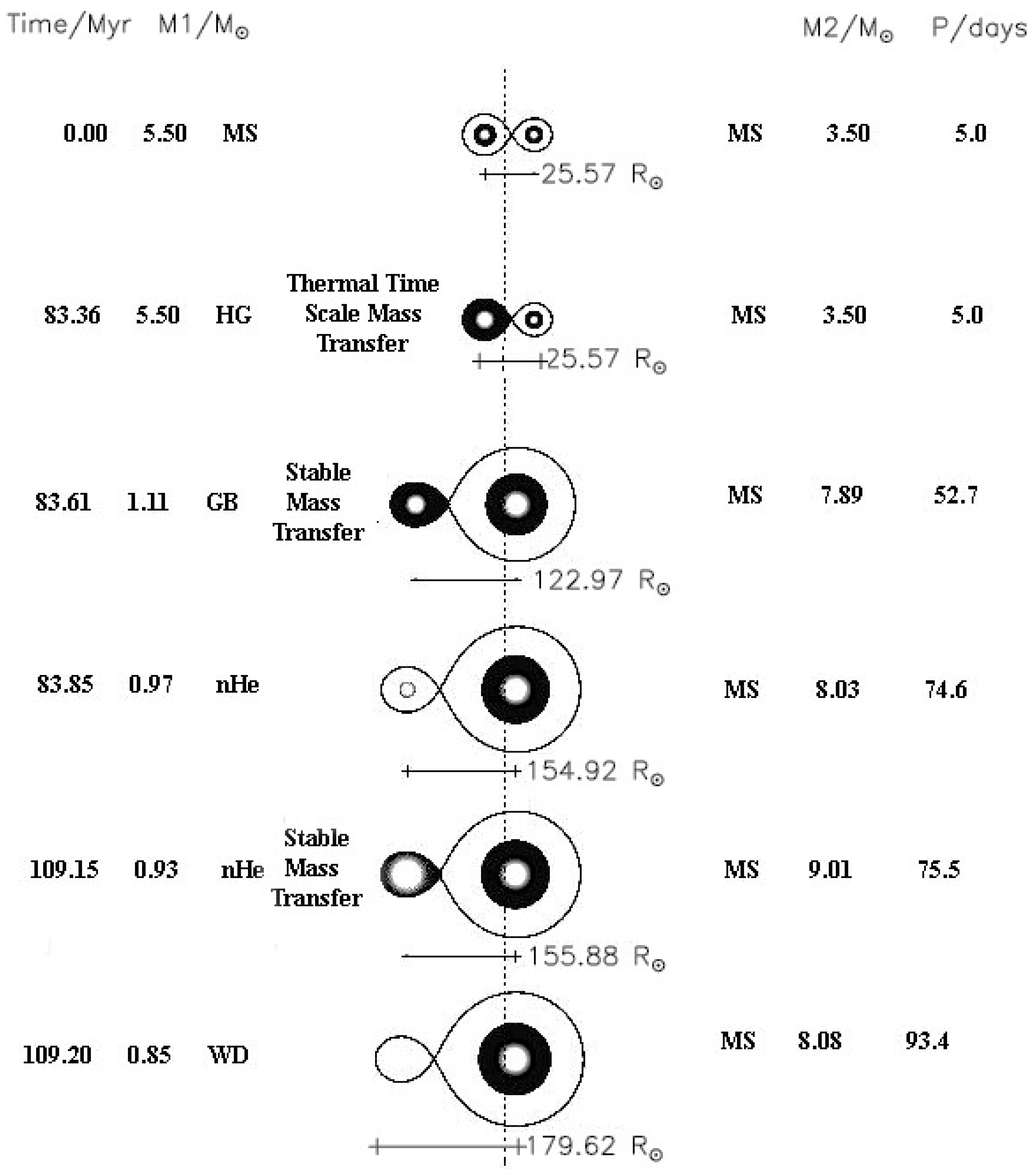
Disclaimer/Publisher’s Note: The statements, opinions and data contained in all publications are solely those of the individual author(s) and contributor(s) and not of MDPI and/or the editor(s). MDPI and/or the editor(s) disclaim responsibility for any injury to people or property resulting from any ideas, methods, instructions or products referred to in the content. |
© 2025 by the author. Licensee MDPI, Basel, Switzerland. This article is an open access article distributed under the terms and conditions of the Creative Commons Attribution (CC BY) license (https://creativecommons.org/licenses/by/4.0/).
Share and Cite
Kholtygin, A. Optical and X-Ray Variability of Gamma Cas Analogs. Galaxies 2025, 13, 109. https://doi.org/10.3390/galaxies13050109
Kholtygin A. Optical and X-Ray Variability of Gamma Cas Analogs. Galaxies. 2025; 13(5):109. https://doi.org/10.3390/galaxies13050109
Chicago/Turabian StyleKholtygin, Alexander. 2025. "Optical and X-Ray Variability of Gamma Cas Analogs" Galaxies 13, no. 5: 109. https://doi.org/10.3390/galaxies13050109
APA StyleKholtygin, A. (2025). Optical and X-Ray Variability of Gamma Cas Analogs. Galaxies, 13(5), 109. https://doi.org/10.3390/galaxies13050109






